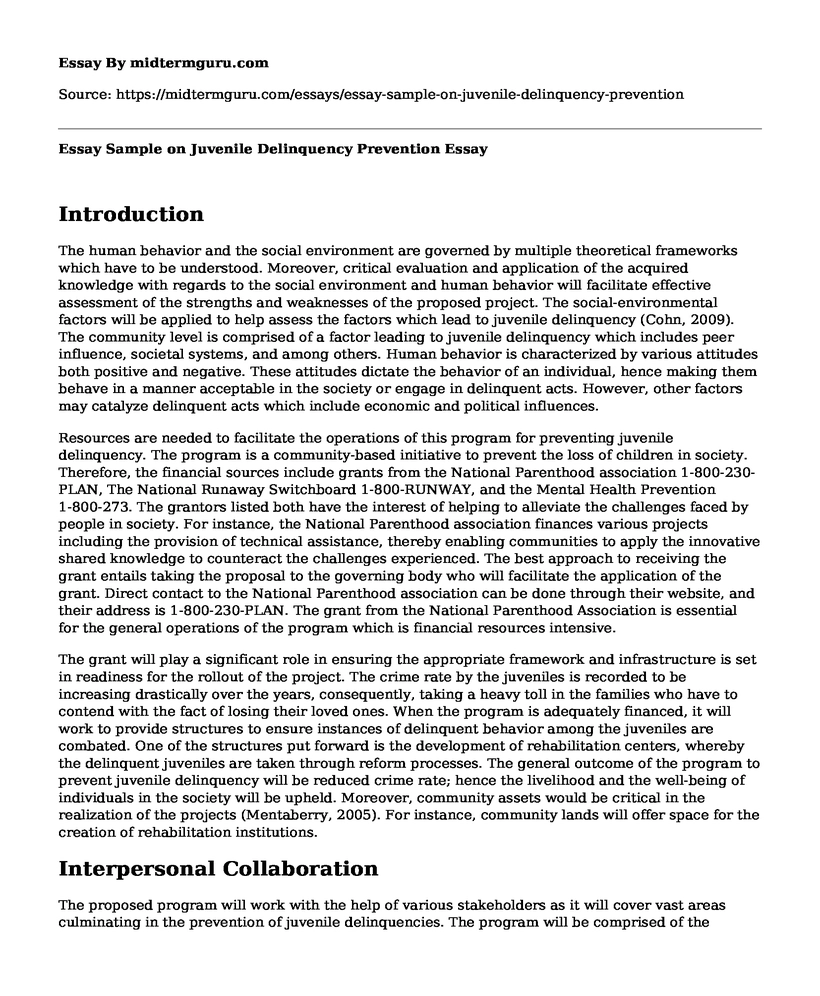Introduction
The human behavior and the social environment are governed by multiple theoretical frameworks which have to be understood. Moreover, critical evaluation and application of the acquired knowledge with regards to the social environment and human behavior will facilitate effective assessment of the strengths and weaknesses of the proposed project. The social-environmental factors will be applied to help assess the factors which lead to juvenile delinquency (Cohn, 2009). The community level is comprised of a factor leading to juvenile delinquency which includes peer influence, societal systems, and among others. Human behavior is characterized by various attitudes both positive and negative. These attitudes dictate the behavior of an individual, hence making them behave in a manner acceptable in the society or engage in delinquent acts. However, other factors may catalyze delinquent acts which include economic and political influences.
Resources are needed to facilitate the operations of this program for preventing juvenile delinquency. The program is a community-based initiative to prevent the loss of children in society. Therefore, the financial sources include grants from the National Parenthood association 1-800-230-PLAN, The National Runaway Switchboard 1-800-RUNWAY, and the Mental Health Prevention 1-800-273. The grantors listed both have the interest of helping to alleviate the challenges faced by people in society. For instance, the National Parenthood association finances various projects including the provision of technical assistance, thereby enabling communities to apply the innovative shared knowledge to counteract the challenges experienced. The best approach to receiving the grant entails taking the proposal to the governing body who will facilitate the application of the grant. Direct contact to the National Parenthood association can be done through their website, and their address is 1-800-230-PLAN. The grant from the National Parenthood Association is essential for the general operations of the program which is financial resources intensive.
The grant will play a significant role in ensuring the appropriate framework and infrastructure is set in readiness for the rollout of the project. The crime rate by the juveniles is recorded to be increasing drastically over the years, consequently, taking a heavy toll in the families who have to contend with the fact of losing their loved ones. When the program is adequately financed, it will work to provide structures to ensure instances of delinquent behavior among the juveniles are combated. One of the structures put forward is the development of rehabilitation centers, whereby the delinquent juveniles are taken through reform processes. The general outcome of the program to prevent juvenile delinquency will be reduced crime rate; hence the livelihood and the well-being of individuals in the society will be upheld. Moreover, community assets would be critical in the realization of the projects (Mentaberry, 2005). For instance, community lands will offer space for the creation of rehabilitation institutions.
Interpersonal Collaboration
The proposed program will work with the help of various stakeholders as it will cover vast areas culminating in the prevention of juvenile delinquencies. The program will be comprised of the individual under the age of 21 years. Therefore, sufficient staff of about 100 in number will be required, comprised of various skills including psychology professions, community workers, and other skilled workers. The skills for the community workers include being compassionate, listening, and patience when dealing with the juveniles. Physical assets such as land and community water sources will help to offer physical space for the project and water requirements respectively. The expected rehabilitation time is one month for every complete cycle. Creation of the timeline should be a collaborated effort with the help of the juvenile guardians and the school system (Cohn, 2009).
References
Cohn, Y. (2009). Delinquency Prevention - A System Approach. Juvenile And Family Court Journal, 28(3), 15-24. doi: 10.1111/j.1755-6988.1977.tb01329.x
Mentaberry, M. (2005). JUVENILE DELINQUENCY GUIDELINES: Improving Court Practice in Juvenile Delinquency Cases. Juvenile And Family Court Journal, 56(3), 40-40. doi: 10.1111/j.1755-6988.2005.tb00108.x
Cite this page
Essay Sample on Juvenile Delinquency Prevention . (2022, Sep 14). Retrieved from https://midtermguru.com/essays/essay-sample-on-juvenile-delinquency-prevention
If you are the original author of this essay and no longer wish to have it published on the midtermguru.com website, please click below to request its removal:
- Essay Sample on Criminal Justice System
- Criminal Law Case Study Critique
- Essay Sample on Business Management: Law and Strategy Concept
- Paper Example on Business Law: E-mails as Contracts
- The Cognitive Dissonance Theory and the Stanford Prison Experiment - Research Paper
- Research Paper on African Americans and the Criminal Justice System
- Collaboration in Criminal Justice: Need & Principles - Essay Sample







